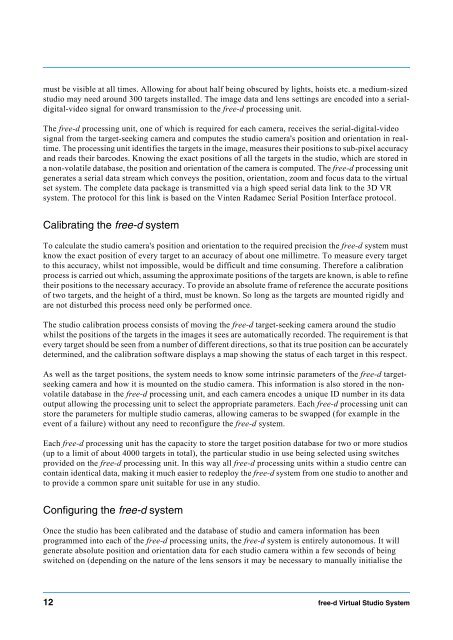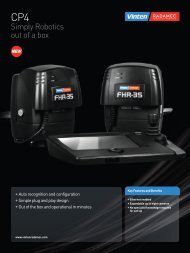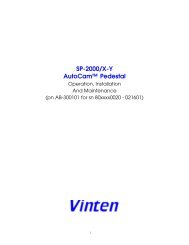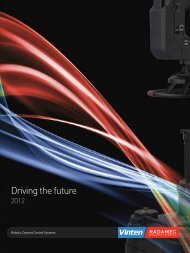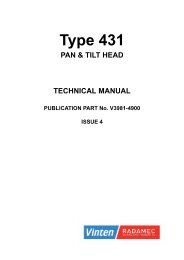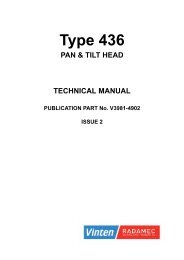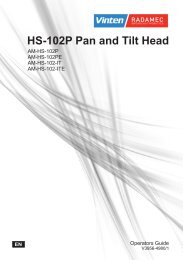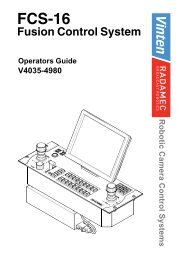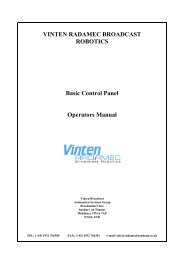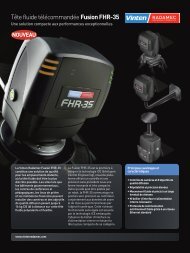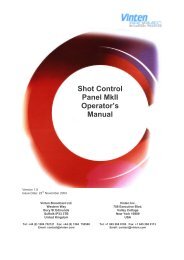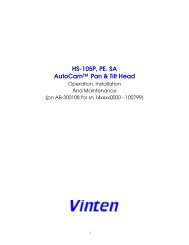free-d Virtual Studio System Operators Guide - Vinten Radamec
free-d Virtual Studio System Operators Guide - Vinten Radamec
free-d Virtual Studio System Operators Guide - Vinten Radamec
Create successful ePaper yourself
Turn your PDF publications into a flip-book with our unique Google optimized e-Paper software.
must be visible at all times. Allowing for about half being obscured by lights, hoists etc. a medium-sized<br />
studio may need around 300 targets installed. The image data and lens settings are encoded into a serialdigital-video<br />
signal for onward transmission to the <strong>free</strong>-d processing unit.<br />
The <strong>free</strong>-d processing unit, one of which is required for each camera, receives the serial-digital-video<br />
signal from the target-seeking camera and computes the studio camera's position and orientation in realtime.<br />
The processing unit identifies the targets in the image, measures their positions to sub-pixel accuracy<br />
and reads their barcodes. Knowing the exact positions of all the targets in the studio, which are stored in<br />
a non-volatile database, the position and orientation of the camera is computed. The <strong>free</strong>-d processing unit<br />
generates a serial data stream which conveys the position, orientation, zoom and focus data to the virtual<br />
set system. The complete data package is transmitted via a high speed serial data link to the 3D VR<br />
system. The protocol for this link is based on the <strong>Vinten</strong> <strong>Radamec</strong> Serial Position Interface protocol.<br />
Calibrating the <strong>free</strong>-d system<br />
To calculate the studio camera's position and orientation to the required precision the <strong>free</strong>-d system must<br />
know the exact position of every target to an accuracy of about one millimetre. To measure every target<br />
to this accuracy, whilst not impossible, would be difficult and time consuming. Therefore a calibration<br />
process is carried out which, assuming the approximate positions of the targets are known, is able to refine<br />
their positions to the necessary accuracy. To provide an absolute frame of reference the accurate positions<br />
of two targets, and the height of a third, must be known. So long as the targets are mounted rigidly and<br />
are not disturbed this process need only be performed once.<br />
The studio calibration process consists of moving the <strong>free</strong>-d target-seeking camera around the studio<br />
whilst the positions of the targets in the images it sees are automatically recorded. The requirement is that<br />
every target should be seen from a number of different directions, so that its true position can be accurately<br />
determined, and the calibration software displays a map showing the status of each target in this respect.<br />
As well as the target positions, the system needs to know some intrinsic parameters of the <strong>free</strong>-d targetseeking<br />
camera and how it is mounted on the studio camera. This information is also stored in the nonvolatile<br />
database in the <strong>free</strong>-d processing unit, and each camera encodes a unique ID number in its data<br />
output allowing the processing unit to select the appropriate parameters. Each <strong>free</strong>-d processing unit can<br />
store the parameters for multiple studio cameras, allowing cameras to be swapped (for example in the<br />
event of a failure) without any need to reconfigure the <strong>free</strong>-d system.<br />
Each <strong>free</strong>-d processing unit has the capacity to store the target position database for two or more studios<br />
(up to a limit of about 4000 targets in total), the particular studio in use being selected using switches<br />
provided on the <strong>free</strong>-d processing unit. In this way all <strong>free</strong>-d processing units within a studio centre can<br />
contain identical data, making it much easier to redeploy the <strong>free</strong>-d system from one studio to another and<br />
to provide a common spare unit suitable for use in any studio.<br />
Configuring the <strong>free</strong>-d system<br />
Once the studio has been calibrated and the database of studio and camera information has been<br />
programmed into each of the <strong>free</strong>-d processing units, the <strong>free</strong>-d system is entirely autonomous. It will<br />
generate absolute position and orientation data for each studio camera within a few seconds of being<br />
switched on (depending on the nature of the lens sensors it may be necessary to manually initialise the<br />
12 <strong>free</strong>-d <strong>Virtual</strong> <strong>Studio</strong> <strong>System</strong>


